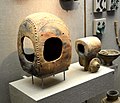Bronze Age Europe
The European Bronze Age is characterized by
Arsenical bronze was produced in some areas from the 4th millennium BC onwards, prior to the introduction of tin bronze. Tin bronze foil had already been produced in southeastern Europe on a small scale in the Chalcolithic era, with examples from Pločnik in Serbia dated to c. 4650 BC, as well as 14 other artefacts from Bulgaria and Serbia dated to before 4000 BC, showing that early tin bronze developed independently in Europe 1500 years before the first tin bronze alloys in the Near East. This bronze production lasted for c. 500 years in the Balkans but disappeared at the end of the 5th millennium, coinciding with the "collapse of large cultural complexes in north-eastern Bulgaria and Thrace in the late fifth millennium BC". Tin bronzes using cassiterite tin were subsequently reintroduced to the area some 1500 years later.[2]
History
Aegean
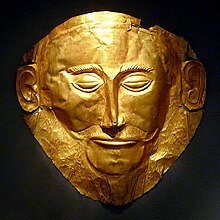
The
Knowledge of navigation was well developed at this time and reached a peak of skill not exceeded until a method was discovered (or perhaps rediscovered) to determine longitude around AD 1750.
Around 1600 BC, the eruption of Thera destroyed the site of Akrotiri and damaged Minoan sites in eastern Crete. The further impact of this event is poorly understood.[4]

Starting in the 15th century BC, the
Southeast Europe
A study in the journal Antiquity from 2013 reported the discovery of a tin bronze foil from the Pločnik archaeological site dated to c. 4650 BC, as well as 14 other artefacts from Serbia and Bulgaria dated to before 4000 BC, showed that early tin bronze was more common than previously thought and developed independently in Europe 1,500 years before the first tin bronze alloys in the Near East. The production of complex tin bronzes lasted for c. 500 years in the Balkans. The authors reported that evidence for the production of such complex bronzes disappears at the end of the 5th millennium coinciding with the "collapse of large cultural complexes in north-eastern Bulgaria and Thrace in the late fifth millennium BC". Tin bronzes using cassiterite tin would be reintroduced to the area again some 1,500 years later.[9]
Caucasus
The Maykop culture was the major early Bronze Age culture in the North Caucasus. Some scholars date arsenical bronze artifacts in the region as far back as the mid-4th millennium BC.[10]
Eastern Europe
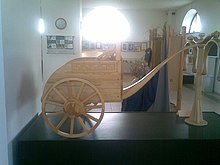
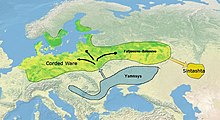
The Yamnaya culture[a] was a late copper age/early Bronze Age culture dating to the 36th–23rd centuries BC. The culture was predominantly nomadic, with some agriculture practiced near rivers and a few hill-forts.
The
Central Europe
In
The late Bronze Age
Italy

The Italian Bronze Age is conditionally divided into four periods: The Early Bronze Age (2300–1700 BC), the Middle Bronze Age (1700–1350 BC), the Recent Bronze Age (1350–1150 BC), the Final Bronze Age (1150–950 BC).[11]
During the second millennium BC, the
Northern Europe
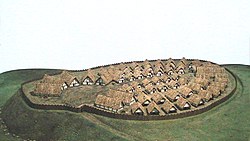
In northern
The age is divided into the periods I–VI, according to Oscar Montelius. Period Montelius V, already belongs to the Iron Age in other regions.
British Isles

In
Also, the burial of dead (which until this period had usually been communal) became more individual. For example, whereas in the Neolithic a large chambered cairn or long barrow was used to house the dead, the 'Early Bronze Age' saw people buried in individual barrows (also commonly known and marked on modern British Ordnance Survey maps as Tumuli), or sometimes in cists covered with cairns.
The greatest quantities of bronze objects found in England were discovered in East Cambridgeshire, where the most important finds were done in Isleham (more than 6500 pieces).[12]
Western Mediterranean
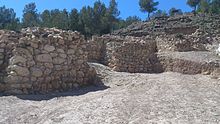
Preceded by the Chalcolithic sites of Los Millares, the Argaric culture flourished in southeastern Iberia in from 2200 BC to 1550 BC,[13] when depopulation of the area ensued along with disappearing of copper–bronze–arsenic metallurgy.[14] The most accepted model for El Argar has been that of an early state society, most particularly in terms of class division, exploitation, and coercion,[15] with agricultural production, maybe also human labour, controlled by the larger hilltop settlements,[16] and the elite using violence in practical and ideological terms to clamp down on the population.[17] Ecological degradation, landscape opening, fires, pastoralism, and maybe tree cutting for mining have been suggested as reasons for the collapse.[18]
The culture of the
Atlantic Europe
The Atlantic Bronze Age is a cultural complex of the Bronze Age period of approximately 1300–700 BC that includes different cultures in
In the context of Atlantic Bronze Age on Iberian Peninsula, and according to radiocarbon dating, the Early Bronze Age began on the Northern Iberian Plateau in 2100 cal. BC and Late Bronze Age in 1350 cal. BC.
Gallery
Maps
-
Diffusion of metallurgy in Europe
-
Steppe expansions and migrations
-
Influence of the Bell Beaker culture
-
Cultures of the Middle Bronze Age
-
Europe in the Late Bronze Age
Artefacts
-
Germany, 1800 BC
-
Avanton gold hat, France, 1400 BC
-
Minoan rhyton, Crete, 1500 BC
-
Bronze boat model, Sardinia , c. 1000 BC
-
Mold cape, Britain, c. 1900–1700 BC
-
Gold diadem, Spain, c. 1600 BC
-
Cult chariot model, Serbia, c. 1300 BC
-
Ceremonial bronze dirk, Netherlands, c. 1500 BC
-
Gold lunula and discs, Ireland, c. 2200 BC
-
Wagon models, Russia, c. 2100 BC
-
Marble figurine, Cycladic Islands, 2700 BC
-
Bronze collar, Sweden, c. 1400 BC
-
Bronze dagger, Switzerland, c. 2000 BC
-
Bronze cauldron,Hungary, c. 1000 BC
-
Bronze axes & armrings, Poland, c. 1000 BC
-
Gold necklace, Belgium, c. 1000 BC
-
Borodino treasure,Moldova, c. 1700 BC
-
Bronze shield, Czech Republic, c. 1200 BC
-
Bronze sword, Austria, c. 1300 BC
-
Silver and gold axe, Montenegro, c. 2200 BC
-
Gold bull figurine, North Caucasus, c. 3200 BC
See also
- Chariot burial
- Megalithic tomb
- Old European hydronymy
- Helladic period
- Nordic Bronze Age
- Argaric culture
- Atlantic Bronze Age
Notes
- ^ Also known as Pit Grave culture or Ochre Grave culture
References
- ^ a b "Ancient Greece". British Museum. Archived from the original on 2015-09-23. Retrieved 2015-05-06.
- .
- ^ Waldman, C., & Mason, C. (2006). Encyclopedia of European peoples. Infobase Publishing. pp. 524.
- ISBN 978-0199873609.
- ISBN 9781107067134.
- ^ Schofield 2006, pp. 71–72
- ISBN 9780892368679.
- ISBN 0-415-36336-5. Archivedfrom the original on 2016-05-03. Retrieved 2016-04-02.
- (PDF) from the original on 2018-11-19. Retrieved 2019-06-11.
- ISBN 978-1-884964-98-5. Archivedfrom the original on 2016-05-06. Retrieved 2015-10-25.
- ISBN 978-0684806686. Archived from the original(PDF) on 2016-01-09. Retrieved 2019-02-06.
- ISBN 1-85074-477-7., p. 81-88
- ISBN 978-1-78925-627-7.
- ^ Carrión et al. 2007, p. 1472.
- .
- ^ Chapman 2008, pp. 208–209.
- ^ Legarra Herrero 2021, p. 52.
- .
- ISSN 1435-0157.
- ISBN 9788496606289.
- ISBN 9781407315195.
- .
- ^ Waddell, J. 1998. The Prehistoric Archaeology of Ireland. Galway.
- ^ Eogan, G. 1983. The Hoards of the Irish Later Bronze Age. Dublin
- .
External links
 Media related to Bronze Age Europe at Wikimedia Commons
Media related to Bronze Age Europe at Wikimedia Commons













![Bronze chariot wheel, Romania, c. 1200 BC[25]](http://upload.wikimedia.org/wikipedia/commons/thumb/f/f2/Romania_Bronze_wheel_1000_BC.jpg/120px-Romania_Bronze_wheel_1000_BC.jpg)



